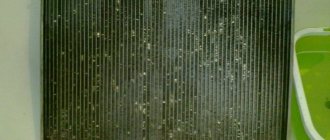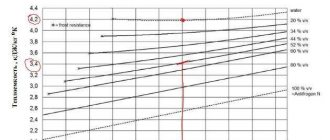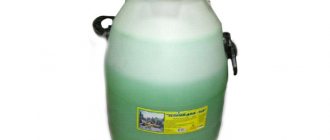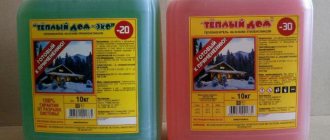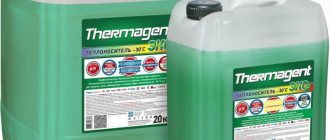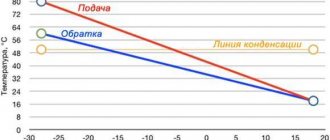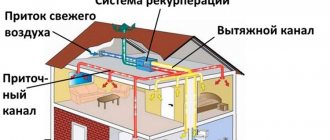Since the main task of heating systems is to transfer heat from heating boilers to radiators, a key factor in the efficiency of such a system is the choice of coolant. As you know, the coolant can be water, oil or an alcohol-containing solution, but the most practical in most respects will be a special non-freezing liquid - antifreeze.
Antifreeze is preferred as a coolant due to its unique properties:
- Low crystallization (freezing) threshold;
- Elevated boiling point from 105°C to 135°C;
- Low viscosity, making heat transfer even more efficient;
- Availability on the market.
Antifreezes are divided into 3 conditional groups: based on glycerin, propylene glycol or ethylene glycol. Each of these substances has its own characteristics and chemical composition, which is why the use of a particular antifreeze depends on many parameters, such as the area of application, the type of equipment, the materials from which it is made, climate and others. Let's take a closer look at them.
How and with what to dilute the coolant?
Climate control systems are an effective, but at the same time quite capricious mechanism that can fail at the most unexpected moment.
Heating equipment - at the height of the winter season, air conditioning systems - in the summer heat. The reasons are varied: from sudden power outages to wear and tear of individual components of the utility network. If you use water as the coolant for the climate system, then at subzero temperatures there is a high risk of the heating circuit freezing. This leads to irreparable consequences - destruction of pipelines and equipment. To avoid costly repairs, it is important to use non-freezing liquids - industrial antifreezes and coolants. Glycol-based compositions are very popular in the industrial coolant market. The consumer has a choice: buy a ready-made composition with a package of anti-corrosion additives or purchase a solution of the glycol concentration of interest in bulk. In order to comply with all requirements, it is important to know the composition of glycol coolants, thermophysical properties, operating features and dilution rules.
201301230950_15
Why is methanol added to the coolant?
Mainly - to reduce the overall viscosity/density of the “mixture” into which the manufacturer swelled diethylene glycol, glycerin, and propylene glycol. But methanol is a low-boiling liquid (boiling point = 64.7°C at atmospheric pressure!), and therefore its presence immediately lowers the overall boiling point of the “mixture,” which is a scourge in the summer. In addition, methanol is toxic, volatile, and a carcinogen. It also increases cavitation wear. Finally, methanol is a strong solvent and, when hot, damages rubber and polymer parts that it comes into contact with.
What do designations like G11, G12 mean?
These designations are not official. The fashion for them was generated by Volkswagen, for whose cars the VW coolant G11 and VW coolant G12 were produced. Thus, the G11 and G12 symbols are associated with this brand - and only with it. As a rule, antifreeze manufacturers do not indicate the components included in the antifreeze. But in any case, it makes no sense to look for G11 or G12 in the store.
Coolant requirements for the climate system
Any coolant is a working medium intended for the redistribution and transfer of thermal energy. A correctly selected and prepared composition allows you to optimize the operation of the circuit, increase the efficiency of the utility network, protect equipment from corrosion and minimize the risk of failure.
When choosing a coolant, it is important to consider the following features:
- The high heat capacity of the composition allows it to accumulate and deliver thermal energy to radiators with minimal losses.
- Wide range of operating temperatures corresponding to the climatic conditions of the region and the operating characteristics of the facility.
- Inertness of antifreeze in relation to pipes, radiators, circulation pump and other system equipment.
- Resistance to the formation of corrosion spots on the washed surface.
- Recommended service life of the composition.
The main advantage of modern glycol-based antifreezes for industrial premises is the ability to withstand negative temperatures, protect equipment from scale and rust formation. This is ensured by the introduction of anti-corrosion additives into the composition, which extend the service life of the coolant. In the case of products from the Hot Stream line from TECHNOFORM, the recommended service life is 5-10 years.
Compared to water, glycol solution:
- Has a viscosity 3-5 times higher. This requires the use of pumping equipment with a productivity of at least 10-15% higher.
- Less heat-intensive. At the same heating, glycol-based coolants accumulate and release approximately 15% less thermal energy.
- It is more fluid, which places increased demands on sealing materials and system connections.
With all the features described above, glycol has an incomparable advantage: even when cooled to extremely low temperatures (-60 degrees), the solution retains its original properties and does not freeze.
Rules for operating complexes with glycerin antifreeze
Glycerin coolants have a long service life if the basic rules are observed:
- Antifreeze must not be allowed to overheat. Otherwise, the anti-corrosion impurities at the heart of its composition may disintegrate and form deposits on the surface of the heating elements, which impairs the operation of the heating system as a whole;
- The low coefficient of surface tension of the composition helps reduce swelling of the seals. To reduce the likelihood of leaks, it is necessary to make additional tightening at the junctions of different elements;
- At low temperatures, the coolant in the pipes will have a viscous state with individual crystals of the substance. When starting the equipment, you must first turn on the minimum speed of the heater and increase it gradually. Such a start will avoid premature breakdown of the boiler. The heated composition will have all its original properties.
Read also: Starting the heating: connection and startup procedure
How to properly dilute the coolant and is it worth doing?
First, let's answer the main question: if you are interested in the possibility of a process from the point of view of thermophysics, yes, it is possible. Before you begin preparing the solution for pouring into the system, you need to carry out a number of preparatory measures. First of all, calculate the required proportions taking into account the concentration of the original solution and the freezing point of the finished product after dilution. You can mix water and antifreeze in two ways: by pouring separately until the operating pressure in the circuit is reached, or by connecting the components of the solution in advance. The first method is rarely used, because Separate addition of water and glycol is fraught with serious problems:
- Uneven heating in certain sections of the pipeline due to poor mixing of liquids.
- Interruptions in the operation of the pump or its stop caused by heterogeneity of the medium.
- Foaming of the solution, the consequences can only be eliminated by completely draining the antifreeze from the system.
Dynamic viscosity of an aqueous glycerol solution
The viscosity of an aqueous solution of glycerin is given in the table in the range of mixture temperatures from zero to one hundred degrees Celsius and glycerin concentration from 10% to 70%. It is noteworthy that adding only 10% (by weight) glycerol to water can increase the dynamic viscosity of the solution by ~30%.
| Viscosity of aqueous glycerol solution (content in percent by weight) | |||||||
| Temperature | 10% | 20% | 30% | 40% | 50% | 60% | 70% |
| OS | μ, Pa • s | μ, Pa • s | μ, Pa • s | μ, Pa • s | μ, Pa • s | μ, Pa • s | μ, Pa • s |
| 2,44•10-3 | 3,44•10-3 | 5,14•10-3 | 8,25•10-3 | 14,6•10-3 | 29,9•10-3 | 76,0•10-3 | |
| 20 | 1,31•10-3 | 1,76•10-3 | 2,5•10-3 | 3,72•10-3 | 6,0•10-3 | 10,8•10-3 | 22,5•10-3 |
| 40 | 0,826•10-3 | 1,07•10-3 | 1,46•10-3 | 2,07•10-3 | 3,10•10-3 | 5,08•10-3 | 9,4•10-3 |
| 60 | 0,575•10-3 | 0,731•10-3 | 0,956•10-3 | 1,30•10-3 | 1,86•10-3 | 2,85•10-3 | 4,86•10-3 |
| 80 | — | — | 0,69•10-3 | 0,918•10-3 | 1,25•10-3 | 1,84•10-3 | 2,9•10-3 |
| 100 | — | — | — | 0,668•10-3 | 0,91•10-3 | 1,28•10-3 | 1,93•10-3 |
Is it possible to dilute the coolant with water?
It is better to ask this question to the manufacturer. Some working compositions are not recommended to be diluted with water, others are perfectly diluted without loss of thermophysical properties. For example, concentrated solutions of glycols can be purchased in bulk and then independently brought to a given working concentration. The only requirement is to use demineralized water when diluting, because... High salt content may cause sediment to form.
Heat capacity of an aqueous solution of glycerol
Estimates of the heat capacity of an aqueous glycerol solution are given in the table for temperatures from 20 to 80 degrees Celsius and glycerol concentrations from 10 to 70 percent. With increasing glycerol concentration, the thermal conductivity of the solution decreases. Under normal conditions and a content of 10% glycerol, the heat capacity of the mixture is ~2 times less than the heat capacity of pure water.
| Heat capacity of a mixture of glycerin (content in percent by weight) with water | |||||||
| Temperature | 10% | 20% | 30% | 40% | 50% | 60% | 70% |
| OS | kJ/(kg•oC) | kJ/(kg•oC) | kJ/(kg•oC) | kJ/(kg•oC) | kJ/(kg•oC) | kJ/(kg•oC) | kJ/(kg•oC) |
| 20 | 1,998 | 1,907 | 1,816 | 1,725 | 1,634 | 1,542 | 1,452 |
| 40 | 2,002 | 1,916 | 1,830 | 1,744 | 1,659 | 1,573 | 1,487 |
| 60 | 2,010 | 1,929 | 1,848 | 1,767 | 1,687 | 1,606 | 1,525 |
| 80 | 2,024 | 1,948 | 1,871 | 1,795 | 1,718 | 1,642 | 1,608 |
Features of dilution of ethylene glycol
To dilute concentrated ethylene glycol, demineralized softened water with a minimum content of magnesium and calcium salts is used. If anti-corrosion additives are added during the dilution process, the water hardness should not exceed 5 mg per equivalent. For convenience, you can use the following table:
| Freezing point of the working composition | Volume of ethylene glycol, in liters | Volume of water, in liters |
| -20 °C | 54 | 60 |
| -25 °C | 60 | 40 |
| -30 °C | 65 | 35 |
| -40 °C | 77 | 23 |
Important! It is not recommended to use pure ethylene glycol. It has increased viscosity and low heat capacity, which negatively affects the efficiency of the equipment.
Density of aqueous glycerol solution
The density of a mixture of glycerin and water is given in the table for glycerin concentrations from 10 percent to 70 percent by weight in the temperature range from zero to one hundred degrees Celsius.
| Density of aqueous glycerol solution (content in percent by weight) | |||||||
| Temperature | 10% | 20% | 30% | 40% | 50% | 60% | 70% |
| OS | ρ, g/cm3 | ρ, g/cm3 | ρ, g/cm3 | ρ, g/cm3 | ρ, g/cm3 | ρ, g/cm3 | ρ, g/cm3 |
| 1,025 | 1,052 | 1,079 | 1,107 | 1,135 | 1,163 | 1,192 | |
| 20 | 1,022 | 1,047 | 1,073 | 1,099 | 1,126 | 1,154 | 1,181 |
| 40 | 1,016 | 1,039 | 1,064 | 1,089 | 1,115 | 1,142 | 1,169 |
| 60 | 1,006 | 1,030 | 1,053 | 1,078 | 1,103 | 1,130 | 1,156 |
| 80 | 0,994 | 1,017 | 1,041 | 1,066 | 1.091 | 1,117 | 1.144 |
| 100 | 0,982 | 1,004 | 1,027 | 1,052 | 1,077 | 1,104 | 1,302 |
Rules for diluting propylene glycol
To prepare a coolant based on concentrated propylene glycol, demineralized water is used. Dilution in different proportions, by volume or weight, is acceptable. For convenience, you can use the following information:
| Volume concentration in % | Density at 20°C, g/cm 3 | Freezing temperature, °C |
| 25 | 1,023 | -10 |
| 30 | 1,029 | -13 |
| 35 | 1,033 | -17 |
| 40 | 1,037 | -21 |
| 45 | 1,042 | -26 |
| 50 | 1,045 | -32 |
Propylene glycol coolants are not used in systems with galvanized pipes; prolonged exposure leads to peeling of the material.
Keep in mind that when preparing working trains, precautions and fire safety measures must be observed. Work may only be carried out in a well-ventilated area, wearing personal protective equipment. But it is better to buy a ready-made solution and entrust pouring the liquid into the system to professionals.
Important! Do not mix coolants from different manufacturers. Each brand uses its own package of corrosion inhibitors, which can conflict in composition and lead to loss of properties.
What types of antifreeze are there, which one is better to choose, features of their use
When talking about the use of antifreeze for heating systems, you need to understand what it is and which antifreeze to choose. These are aqueous solutions of polyhydric alcohols, although not so long ago a new type of antifreeze appeared, for which glycerin was used as a base. In order to figure out which option is best to choose, let’s take a closer look at the characteristics and properties of each of them.
Types of antifreeze for the heating system of a country house
Today, the production of antifreeze is based on the use of two substances: propylene glycol and ethylene glycol. The first option is more expensive, but it is completely safe, even if taken internally. But it has another serious drawback - it can lose fluidity at low temperatures, to which ethylene glycol would not react.
The best option for filling the heating system is to use a safe coolant based on propylene glycol
It is interesting that, despite all the dangers of using ethylene glycol, it is preferred much more often, which is most likely due to its lower cost.
Antifreezes made on the basis of ethylene glycol are also distinguished by the fact that they are chemically active, have increased fluidity and are capable of foaming. And if foaming can still be combated with the help of special additives, the increased level of fluidity cannot be adjusted. And given that the substance is also toxic, this significantly increases the risks of using such antifreeze.
To summarize, we can say that if it is possible to use propylene glycol for the heating system, then it should be used. Therefore, ethylene glycol will definitely leak wherever possible. And its toxic fumes can cause serious poisoning and further health problems.
The use of toxic ethylene glycol-based coolant requires high-quality connectors and pipes
Conclusion
Glycol coolant is more technologically advanced, safe and effective than water. In some operating conditions it is indispensable. On sale you can find both ready-made formulations and solutions of glycols of various concentrations with a package of additives, which theoretically can be adjusted to the required parameters.
Self-mixing of ethylene and propylene glycol with water is carried out before filling the system, taking into account the manufacturer’s recommendations. But it is best to purchase a solution of ethylene or propylene glycol in bulk. A variety of options, high-quality anti-corrosion additives made in Belgium - all this guarantees long-term and productive operation of the system.
Source
Thermal conductivity of a mixture of glycerin and water
The thermal conductivity values of an aqueous glycerol solution are shown in the table for a temperature range from 20 to 80 degrees Celsius and glycerol concentration from 10% to 70%. With increasing glycerol concentration, the thermal conductivity of the aqueous solution decreases. With a glycerol content of 50%, the thermal conductivity of the mixture is ~29% less than that of pure water.
| Thermal conductivity of a mixture of glycerin (content in percent by weight) with water | |||||||
| Temperature | 10% | 20% | 30% | 40% | 50% | 60% | 70% |
| OS | W/(m•oC) | W/(m•oC) | W/(m•oC) | W/(m•oC) | W/(m•oC) | W/(m•oC) | W/(m•oC) |
| 20 | 0,557 | 0,519 | 0,481 | 0,448 | 0,414 | 0,381 | 0,352 |
| 40 | 0,586 | 0,540 | 0,502 | 0,460 | 0,423 | 0,385 | 0,356 |
| 60 | 0,611 | 0,565 | 0,519 | 0,477 | 0,435 | 0,393 | 0,360 |
| 80 | 0,636 | 0,590 | 0,540 | 0,494 | 0,448 | 0,402 | 0,364 |
We recommend reading: Voltage stabilizer for a gas boiler: which one is better to choose
What is better to use for a home heating system: water or antifreeze?
The standard coolant for autonomous heating systems of private houses is water. It has been used for many years. But recently, manufacturers have begun to propose switching to antifreeze, noting a number of its advantages. To understand whether it is worth using anti-freeze fluid, whether it is a common marketing ploy, and what is generally better for the installed heating system, you should consider and compare the two types of coolant.
Description of the substance
Glycerol is a trihydric alcohol, which differs from ethanol, which has only one atom. The substance is a clean transparent liquid with high viscosity. Glycerin has no color. Alcohol is a food additive. It acts as a preservative, which makes the products thick enough.
Glycerol is made up of three elements: carbon, hydrogen and oxygen. The substance is often obtained from propylene. During its chlorination at high temperatures (from 450 to 5000C), allyl chloride appears. Hypochlorous acid is added to this compound, resulting in the formation of chlorohydrins. At the last stage, they are saponified with alkali. Eventually they turn into alcohol.
The substance can be either plant or technical. The first option is safe for human health. The use of the second can negatively affect the functioning of internal organs. Industrial alcohol is not used in the food industry or in the manufacture of liquids for electronic cigarettes.
The use of antifreeze in the heating system of a private house
Even if the heating system is highly reliable and of good quality, the possibility of freezing in winter cannot be ruled out. The use of antifreeze in the heating system of a private home significantly reduces the risk of this problem. Let's consider what advantages “anti-freeze” devices have, what requirements they must meet, and what are the rules for their use.
Concentration of glycerol by mass and volume in aqueous solution
The table below shows the ratio of the concentration of glycerol in an aqueous solution by weight and volume.
| Glycerol content by weight (percentage) | ||||||||
| 5% | 10% | 20% | 30% | 40% | 50% | 60% | 70% | |
| Glycerin concentration by volume (percentage) | 4,0% | 8,1% | 16,58% | 25,49% | 34,84% | 44,63% | 54,86% | 65,56% |
Monoethylene glycol: history of production, properties, area of use
Monoethylene glycol (MEG) is a dihydric alcohol, the simplest representative of the category of polyhydric alcohols, also called polyols. It is a colorless, somewhat oily liquid with a sweetish taste and odorless. Many people ask the question: are there any differences between monoethylene glycol and ethylene glycol? There is no difference. These are names of the same compound.
TD Roka Chemicals LLC is a manufacturer of antifreeze used as a coolant in heating, air conditioning, heating or cooling systems, as well as automotive coolants.
Our managers will not only place your order, but will also help you formulate it correctly, as well as provide all the necessary information and materials for successful implementation.
To order products, you can contact the sales department by phone +7(8313) 27-52-47.
Products are shipped in any container suitable for you and sent in any way convenient for you to the following cities:
- Buryatia, Altai, Karelia, Komi, Sakha (Yakutia), Tyva, Krasnoyarsk, Vladivostok, Khabarovsk, Blagoveshchensk, Irkutsk, Petropavlovsk-Kamchatsky, Murmansk, Perm, Yuzhno-Sakhalinsk, Tomsk, Tyumen, Khanty-Mansiysk. Moscow, St. Petersburg, Kazan, Ekaterinburg, Yakutsk
Source
Properties
Glycerin is a hygroscopic liquid with a sweet taste. It absorbs water vapor from the air well. Alcohol mixes with water regardless of proportions. When combined with propylene glycol, the liquid becomes fluid.
The melting point of this alcohol is 180C. The substance boils at 2900C. Due to its hygroscopicity, glycerin will always draw water.
Glycerin solution also has the following properties:
- antiseptic effect;
- moisturizing effect;
- preservative component;
- imparting softness and sweetness to products.
The substance actively participates in vaporization. In this regard, it acts as the main component of e-cigarette liquid. Alcohol increases the nutritional value of foods. Due to its preservative properties, they can remain fresh for a long time. Alcohol also cleans surfaces well from grease and dirt, which allows it to be successfully used as a cleaning agent.
The substance is used in the manufacture of dynamite. When it reacts, it burns. As a result, water and carbon dioxide are formed.
Glycerin based coolant
A glycerin-based coolant is a solution of glycerin in water with the addition of various additives and dye.
The presence of glycerin in the coolant reduces its freezing point, which makes the heating system (CO) more resistant to malfunctions that lead to temporary cessation of operation of the heating boiler.
The probability that the glycerin-based coolant will freeze in the lines, which will lead to their rupture and failure of the CO, is significantly less than that which exists for systems using only water as a coolant.
Glycerin in the heating system is the main factor influencing the further choice of the CO project for a private house, the type of heating boiler, the power of installed heating devices (convectors or radiators), the power of the main pump and the list of materials used.
Rules for commercial metering of thermal energy of a coolant: what is it?
Today, almost everything related to individual construction and arrangement of residential buildings is regulated by law.
This case is no exception, since there are special rules for accounting for thermal energy and coolant, which are formulated in the Decree of the Government of the Russian Federation of November 18, 2013. In general, the methodology for commercial metering of the thermal energy of a coolant is an interesting question, although quite complex for the average user. But if you want to understand how certain calculations are made and what the standards used in the future are made of, you can read the documentation on this topic.
According to the rules for commercial metering of thermal energy of the coolant, admission to operation of metering units is carried out by a representative of the energy supply organization
To summarize, it is worth noting that you can buy coolant for the heating system of a country house based on various criteria and factors. For many, the deciding factor is the price of the heating fluid, while others pay more attention to the issue of safety and efficiency. In any case, before purchasing, you should weigh all the arguments in favor of a particular decision.
Coolant temperature graph: requirements and standards
For the coolant, the temperature standard in the heating system is indicated based on the indicators obtained when the liquid has already completed a full circle and returns to the boiler. According to standards, the average daily room temperature should not be less than +8°C for three days.
The water temperature in the heating system should not fall below the dew point
In addition, in addition to the standards that have been provided, the minimum heating in the boiler must also be taken into account
It is very important that the water temperature does not fall below the dew point. Usually this indicator fluctuates between 60-70°C, although some deviations are possible due to the characteristics of the fuel used, as well as the unit itself
If for any reason this rule is violated, condensation will result, which will negatively affect the service life of the device.
Usually this indicator fluctuates between 60-70°C, although some deviations are possible due to the characteristics of the fuel used, as well as the unit itself. If for any reason this rule is violated, condensation will result, which will negatively affect the service life of the device.
In addition, in the process of heating the coolant, such a factor as the air temperature outside the window must be taken into account. That is, if it is very cold outside and the temperature has dropped below -20°C, then the coolant should be heated more strongly
In order for the heating system to work properly and maintain a comfortable temperature in the house, it is necessary to choose the right coolant according to the operational characteristics of the equipment
At the same time, the temperature schedule of the coolant, the limits of which are defined as 30-90 ° C, should not be violated, as this can lead to the paint coatings of the equipment decomposing. And sanitary standards prohibit exceeding these indicators.
Thus, when choosing a coolant for electrode heating boilers and other systems, it is necessary to take into account many factors. Of course, price is an important criterion, and for many it is the determining factor, but do not forget about safety
If possible, it is better not to save money and give preference to the best coolants, which are also characterized by high efficiency.
Technical characteristics of glycerin-based coolants
Glycerin based coolant
When deciding to purchase a coolant produced using glycerin, you should definitely analyze the main parameters of the latter so as not to experience unnecessary difficulties in the future with the operation and maintenance of CO:
- The temperature range in which the specified coolant will operate normally, without significant losses in its consumer parameters.
- The heat capacity of glycerin, i.e. the required amount of coolant that needs to be pumped per unit of time in order to transfer the required amount of heat.
- Viscosity coefficient, which affects the circulation rate of the coolant, the value of the heat transfer coefficient, etc. and its change depending on the temperature of the coolant.
- Corrosive activity, which imposes a number of restrictions on the use of coolant with glycerin additives without adding the required corrosion inhibitors, as well as on the choice of coolant circuit material.
- Issues of safety of using such coolants for the environment and humans.
- Lubricity, which determines the restrictions imposed by the use of the specified coolant on the design of CO elements.
- An indicator of inertness to foaming, which directly affects the efficiency of the transfer pump.
Heating glycerin. Harm from glycerin for the steamer
In terms of its composition, glycerin is a polyhydric simple alcohol, which is used in various industrial sectors. To fill the e-cigar according to the standard scheme, food grade glycerin is used. It has a mild and sweetish taste.
As mentioned above, numerous experiments have revealed that e-cigarette filler with glycerin negatively affects the health of the vaper. The possible consequences of consuming glycerin as an ingredient in e-liquid can be found below.
- Drying. Glycerin causes active hydration, so if you actively inhale the steam, it can cause a sore throat, dry mouth, and dry sinuses. By the way, these are the symptoms that occur in many avid cloud chasers who repeatedly inhale huge amounts of steam. Note that if you have existing diseases of the kidneys and adrenal glands, due to frequent vaping of electrons, the disease may worsen. In addition, consuming glycerin can lead to skin dehydration. Therefore, some vapers advise hardcore vapers to drink a lot of liquid and thus eliminate these consequences.
- Effect on blood vessels. Despite the use of a smaller amount of nicotine in the liquid, doctors have proven the harmful effects of this substance, together with glycerin, on the cardiovascular system of the body not only of vapers, but also of those around them. Today, the maximum permissible dose for humans is extremely difficult to determine. In this case, the permissible harm from vaping is largely determined depending on the body’s predisposition to such diseases.
- Isolation of acrolein. When overheated, glycerin releases acrolein, a strong carcinogen of the 1st hazard class. It has a strong effect on the bronchi, oral mucosa and eye membranes, irritating them.
- Toxicity of vapors. When heated to 390°C, glycerin becomes very difficult to breathe, which subsequently leads to disorders of the respiratory system. It is also worth considering that expensive vapes and certified e-liquids contain the same ingredients as low-quality products in this category. The only difference will be that the former contain harmful substances in smaller quantities. But poison is still poison, regardless of its quantity.
Thermophysical properties of ethylene glycol
Under normal conditions, the viscosity of ethylene glycol is ~19 times greater than the viscosity of water .
| Temperature | Density, ρ | Specific heat capacity, Cp | Kinematic viscosity**, ν | Thermal conductivity, λ | Thermal diffusivity coefficient, a | Prandtl number, Pr |
| OS | kg/m3 | kJ/(kg • K) | m2/s • 106 | W/(m • K) | m2/s • 107 | — |
| 1130,1 | 2,294 | 67,62 | 0,242 | 0,933 | 615,0 | |
| 20 | 1116,1 | 2,382 | 19,17 | 0,249 | 0,938 | 204,0 |
| 40 | 1100,8 | 2,474 | 8,69 | 0,256 | 0,938 | 93,0 |
| 60 | 1087,1 | 2,562 | 4,75 | 0,260 | 0,931 | 51,0 |
| 80 | 1077,0 | 2,650 | 2,98 | 0,262 | 0,922 | 32,4 |
| 100 | 1057,9 | 2,742 | 2,03 | 0,263 | 0,908 | 22,4 |
When carrying out engineering calculations, it is easier to use approximate formulas to determine the physical properties of ethylene glycol.
Density of ethylene glycol
⋆ [kg/m3]
Heat capacity of ethylene glycol
⋆ [J/(kg • K) ]
Thermal conductivity of ethylene glycol
⋆ [W/(m • K) ]
Kinematic viscosity of ethylene glycol
⋆ [m2/s]
Thermal diffusivity of ethylene glycol
⋆ [m2/s]
The effect of a substance on the body when smoking
The fumes may contain dangerous neurotoxins. This is especially true for liquids that contain nicotine. A peculiarity of the effect of glycerin on the lungs is that when it is heated, acrolein is released, which has a carcinogenic effect on the respiratory system. The compound settles in the lungs and accumulates there for a long time. Ultimately, it can cause lung cancer in smokers who use e-cigarettes.
When glycerin is inhaled, it causes harm to the body in the form of:
- sore throat;
- dehydration of the oral mucosa;
- dryness in the nasopharynx;
- creating the sensation of a lump in the throat.
Alcohol can have an adverse effect on the kidneys, causing the development of severe pathologies. Glycerin when smoked causes damage to the skin. Its use is harmful to the heart. After entering the body, it begins to act on the blood vessels, disrupting blood circulation in them.
One of the reasons why glycerin can be dangerous is the toxicity of the vapors it produces. When a vape is vaped, a person inhales hot smoke, which simply has a bad effect on the throat, causing laryngeal stenosis and suffocation.
A contraindication for the use of glycerin is a person’s tendency to allergies. When alcohol actively evaporates, allergens enter the body. The situation is aggravated if the vape liquid contains flavorings. Then the person experiences a deterioration in health, and in severe cases, shock may develop.
The negative effect of glycerin on the human body is also due to the risk of pathologies of the reproductive system in men and women. Therefore, smoking e-cigarettes is not beneficial during pregnancy. Glycerin, together with other chemical elements, can provoke severe pathologies of internal organs in the unborn child.
It is not recommended to use alcohol for mixtures if the manufacturer has expired its expiration date.
Important! If you frequently vape during the day, it is possible that your perception of taste and smell may be impaired.
Ethylene glycol for heating systems
Molecular structure of ethylene glycol
Very poisonous composition. Moreover, it is poisonous both in liquid and gaseous form. If you pour such antifreeze into an open heating system, then the design of the expansion tank must be modified. It must have a lid that closes tightly. Holes must be made in the lid to allow gases to escape. Insert a pipe into the hole (also hermetically sealed) and take it outside the room, to the street.
Contact with skin or eyes is highly undesirable. Therefore, even an ordinary fistula can become a serious danger to others. Under no circumstances should it be used in double-circuit heaters, the danger is very serious, do not tempt fate. This is an inexpensive composition. The additive package of ethylene glycol is not as high quality as that of propylene glycol, which is why it is cheaper.
The toxicity is so great that a dose of 350 mg can send a healthy person weighing 80 kg to the next world.
What we have as a result:
- very high toxicity;
- low quality additive package;
- cheap.
The service life is approximately the same as the previous composition. It is also five years, after which a complete replacement is required.
Glycerin in vape
Alcohol is an essential component of liquids used in electronic cigarettes. A typical smoking device consists of a cartridge in the form of a capsule, an atomizer and a battery. Vapes may also contain drip. This is a special device through which liquid is added to the device. Glycerin is poured into the cartridge along with other components. Among them: propylene glycol, nicotine and flavorings with dyes, water.
Alcohol is used in vapes due to its hygroscopicity. The substance is involved in the formation of steam. Under the influence of temperature, the atomizer heats up, which converts the liquid into smoke. This is how the soaring process occurs.
Glycerin can make the liquid more viscous. The presence of alcohol makes it thicker. When making your own vape juice, you can independently adjust the vapor strength. If propylene glycol from the glycol class predominates in the mixture, then the smoke will not be thick. To create abundant steam, you need to pour glycerin and propylene glycol into the cartridge in a ratio of 70/30. Pharmacy glycerin is available for sale. It is significantly diluted with water, which affects its taste.
20140725_011
At one time, we wrote that the only fundamental document regarding antifreezes - they are also “low-freezing cooling liquids” - is called GOST 28084–89, which is already very, very old. And it only applies to liquids made on the basis of ethylene glycol. And if so, then why not release something else, according to our own specifications? So strange liquids appear on sale, claiming to be coolants.
We have already conducted tests of coolants earlier, but for now we suggest that you familiarize yourself with a number of key questions from readers of the magazine “Behind the wheel” and visitors to the website “Behind the wheel.RF” regarding coolants with our comments.
Why has there been talk lately about glycerin in coolant? Is it harmful or beneficial?
Imported manufacturers, under pressure from environmentalists, often use glycerin to reduce the burden on the environment. It partially replaces expensive ethylene glycol. In this case, highly purified glycerin is used, measures have been taken to compensate for thermal decomposition and reduce viscosity to generally accepted values. For humans, glycerin is absolutely harmless, and this is good. Domestic manufacturers often use cheap glycerin to significantly (from 30 to 50%) reduce costs. Unfortunately, the harm from the illiterate use of glycerin is considerable. This:
- rapid (in about 3 months of continuous operation) thermal decomposition of glycerin on heat exchange surfaces with the formation of a mixture of organic acids (including the volatile toxic carcinogen - acrolein) and as a consequence:
a) a significant increase in corrosion activity, especially in the cooling channels of the cylinder block;
b) the need to compensate for this effect (formation of acids) with additional additives;
- high viscosity (67 times more than ethylene glycol) and increased density and, as a consequence:
a) increased mechanical wear of the circulation pump (pump) due to multiple increases in load and increased axial displacement;
b) deterioration of cold start conditions;
c) the need to reduce viscosity by adding a component with low viscosity and density;
— low heat capacity of coolant with glycerin (with a glycerin content of more than 8%), due to which:
a) heat dissipation deteriorates;
b) as a consequence of the previous point, the engine overheats.
201301230949_0–2
How interchangeable are modern coolants?
This depends on three parameters: heat transfer efficiency, corrosion activity, service life. Any “correct” (i.e., meeting at least the requirements of the old GOST) antifreeze performs these functions. To the direct question “Is it possible to mix different coolants?” no serious manufacturer will answer directly. At best, you will hear “undesirable.” Why? Because the additives, while the recipes are generally clear, everyone uses their own, with varying degrees of chemical purity (and therefore cost), i.e. The devil is in the details. So no one can predict how different packages will behave.
How to choose coolant for your car in a store?
First of all, we look at the price. A normal coolant should not cost less than 60 rubles. per kilogram. The brand must be well known; there is no point in playing the lottery. Important: the color of the coolant does not play any role! All coolants are initially colorless. Giving them one color or another is the whim and right of the manufacturer. That is why liquids of the same color can be completely different in composition, while multi-colored ones, on the contrary, can be the same. Color has nothing to do with the chemical composition of coolants.
A good, but difficult way to purchase a product that is known to be of high quality is to check that it has approval from at least one automobile manufacturer. This can be found out on the official website of this manufacturer.
Antifreeze: what is hidden on the car hood
Calculation of coolant volume: simple calculation of technical parameters
When choosing a heating system from the range supplied by various equipment manufacturers, you should pay attention to the amount of liquid that will circulate in it. The efficiency of the installation and comfortable indoor conditions depend on this parameter. It is important to remember that the volume of coolant depends entirely on the number of elements included in the heating system and the type of coolant.
